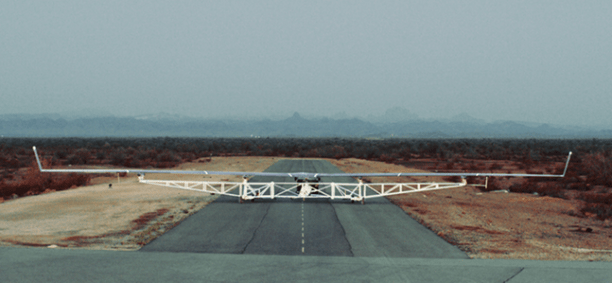
In a recent note on Facebook, Mark Zuckerberg, Facebook’s CEO, announced the first successful flight of the Aquila drone, a large solar powered UAV that has been in development for 2 years. The flight took place in Yuma, Arizona. The long term goal of the UAV initiative is to provide internet access to regions of the world that currently do not have it. In his note Zuckerberg states, “It’s all part of our mission to connect the world and help more of the 4 billion people who are not online access all the opportunities of the internet.”
This will be achieved by a drone fleet functioning as a network that relay data via lasers.
Facebook’s first test flight, as reported by Bloomberg, did not end well. When it landed the drone suffered “substantial” damage according to the NTSB which investigated the incident. investigation.; but this flight exceeded expectations. The flight plan called for a 30 minute test; but according to Zuckerberg, the flight was progressing so well, they extended it to 96 minutes.
The test flight provided engineers with data on a variety of the Aquila’s functions including autopilot, motors, batteries, radios, ground station, displays, basic aerodynamic handling, structural viability, and crew training.
Facebook engineers have identified the following challenges going forward:
Sufficient Solar Power — To be successful the drone needs to collect enough energy during daylight hours to fly for 24 hours. That energy needs to be sufficient to power the drone’s propulsion, payload, avionics, heaters, lights, communications, and other systems
Battery power – Keeping the airplane aloft on a long winter night requires a lot of stored energy. According to the engineers, given current and projected battery performance, that means batteries will account for roughly half the mass of the airplane.
Size and speed – the Aquila has a wingspan comparable to a commercial airliner’s but weighs only one-third as much as a car. It is constructed of carbon fiber. The size:weight ration enables the Aquila is to fly much slower than a typical airplane of the same size — about 25 mph at sea level, compared with 50 mph for a glider or more than 200 mph for a commercial airliner. What is challenging in this is that there is no precedent for it. This is new territory.
Financial model – The final solution needs to be financially viable and economically competitive with other network infrastructure solutions. The solution needs to have efficient on board power and communication systems; ensure the aircraft are resilient to structural damage to reduce maintenance costs, and able to stay aloft for long periods of time to keep fleet numbers low; and minimize the amount of human supervision associated with their operation.
You can find the complete update from Facebook’s Andrew Cox and Martin Luis Gomez here.
Frank Schroth is editor in chief of DroneLife, the authoritative source for news and analysis on the drone industry: it’s people, products, trends, and events.
Email Frank
TWITTER:@fschroth